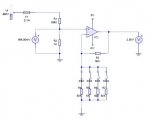Richard Shillito
New Member
I want a PICAXE to read voltages up to around 750v.
Using a 200:1 voltage divider would work fine, and give a value that can be read accuratly using readadc10.
However, I also want to measure lower voltages, eg 2v. Putting that through the voltage divider would give 0.01v - hard to read with much accuracy.
Is it possible to have several voltage dividers (say 5), all connected at the same time. I would have a 1:0 (direct feed), a 5:1, a 20:1 a 100:1 and the 200:1. The PIC would see how many of these read as 255 (eg voltage is higher than supply), and thus get a result to the highest precision possible.
The only problem is you could be feeding 750v straight into the PIC (via the direct link). Is this a problem? I recall hippy posting a circuit where 250v could be fed straight into the PIC via a suitable resistor. Can 750v be fed straight into a PIC (via a suitable resistor)? Will the clamping diodes save me?
Many thanks
Richard
Using a 200:1 voltage divider would work fine, and give a value that can be read accuratly using readadc10.
However, I also want to measure lower voltages, eg 2v. Putting that through the voltage divider would give 0.01v - hard to read with much accuracy.
Is it possible to have several voltage dividers (say 5), all connected at the same time. I would have a 1:0 (direct feed), a 5:1, a 20:1 a 100:1 and the 200:1. The PIC would see how many of these read as 255 (eg voltage is higher than supply), and thus get a result to the highest precision possible.
The only problem is you could be feeding 750v straight into the PIC (via the direct link). Is this a problem? I recall hippy posting a circuit where 250v could be fed straight into the PIC via a suitable resistor. Can 750v be fed straight into a PIC (via a suitable resistor)? Will the clamping diodes save me?
Many thanks
Richard

